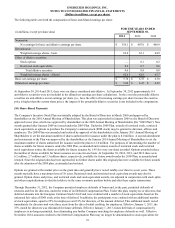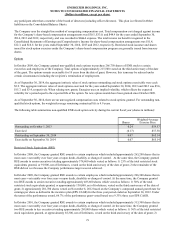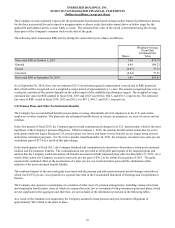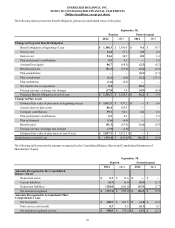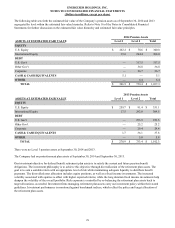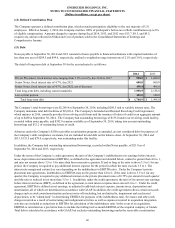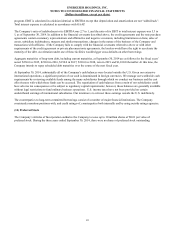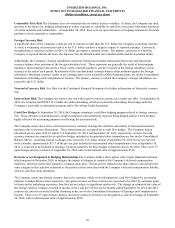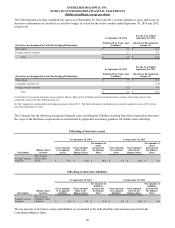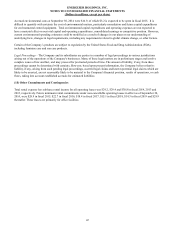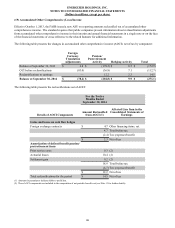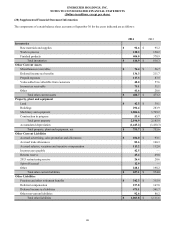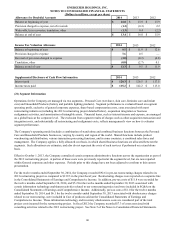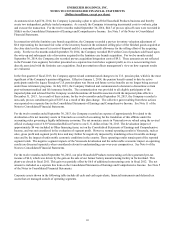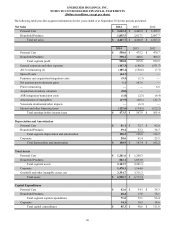Energizer 2014 Annual Report Download - page 86
Download and view the complete annual report
Please find page 86 of the 2014 Energizer annual report below. You can navigate through the pages in the report by either clicking on the pages listed below, or by using the keyword search tool below to find specific information within the annual report.
ENERGIZER HOLDINGS, INC.
NOTES TO CONSOLIDATED FINANCIAL STATEMENTS
(Dollars in millions, except per share)
(15) Shareholders’ Equity
At September 30, 2014, there were 300 million shares of Company common stock authorized, of which approximately 0.2
million shares were reserved for issuance under the 2000 Incentive Stock Plan and 1.5 million shares were reserved for
issuance under the 2009 Incentive Stock Plan as amended and restated.
Beginning in September 2000, the Company’s Board of Directors has approved a series of resolutions authorizing the
repurchase of shares of Energizer common stock, with no commitments by the Company to repurchase such shares. In April
2012, the Board of Directors approved the repurchase of up to ten million shares. This authorization replaced a prior stock
repurchase authorization, which was approved in July 2006. For the twelve months ended September 30, 2014, the Company
repurchased one million shares of the Company's common stock, exclusive of a small number of shares related to the net
settlement of certain stock awards for tax withholding purposes, for a total cost of approximately $94.4. All shares were
purchased in the open market under the Company's current authorization from its Board of Directors. The Company has
approximately five million shares remaining under the above noted Board authorization to repurchase its common stock in the
future. Future share repurchases, if any, would be made on the open market, privately negotiated transactions or otherwise, in
such amounts and at such times as the Company deems appropriate based upon prevailing market conditions, business needs
and other factors.
For the twelve months ended September 30, 2014, total dividends declared to shareholders were $126.2 of which $123.9 were
paid.
Subsequent to the end of fiscal 2014, on November 3, 2014, the Company's Board of Directors declared a dividend for the first
quarter of fiscal 2015 of $0.50 per share of Common Stock, which will be paid on December 16, 2014 and is expected to be
approximately $31.
On June 4, 2013, the Company retired approximately 43 million shares of its treasury stock. These shares are now authorized
but unissued. In accordance with ASC section 505, the treasury stock retirement resulted in a reduction of the following on the
Company's Consolidated Balance Sheet: treasury stock by $2,146.5, common stock by $0.4 and retained earnings by $2,146.1.
There was no effect on the Company's total shareholders' equity as a result of the retirement.
(16) Financial Instruments and Risk Management
The market risk inherent in the Company’s financial instruments and positions represents the potential loss arising from adverse
changes in currency rates, commodity prices, interest rates and the Company’s stock price. Company policy allows derivatives
to be used only for identifiable exposures and, therefore, the Company does not enter into hedges for trading purposes where
the sole objective is to generate profits.
Concentration of Credit Risk The counterparties to derivative contracts consist of a number of major financial institutions and
are generally institutions with which the Company maintains lines of credit. The Company does not enter into derivative
contracts through brokers nor does it trade derivative contracts on any other exchange or over-the-counter markets. Risk of
currency positions and mark-to-market valuation of positions are strictly monitored at all times.
The Company continually monitors positions with, and credit ratings of, counterparties both internally and by using outside
rating agencies. The Company has implemented policies that limit the amount of agreements it enters into with any one party.
While nonperformance by these counterparties exposes the Company to potential credit losses, such losses are not anticipated.
The Company sells to a large number of customers primarily in the retail trade, including those in mass merchandising,
drugstore, supermarket and other channels of distribution throughout the world. Wal-Mart Stores, Inc. and its subsidiaries
accounted for 17.2%, 20.0% and 20.3% of total net sales in fiscal 2014, 2013 and 2012, respectively, primarily in North
America. The Company performs ongoing evaluations of its customers' financial condition and creditworthiness, but does not
generally require collateral. The Company’s largest customer had obligations to the Company with a carrying value of
approximately $85 at September 30, 2014. While the competitiveness of the retail industry presents an inherent uncertainty, the
Company does not believe a significant risk of loss from a concentration of credit risk exists with respect to accounts
receivable.
In the ordinary course of business, the Company enters into contractual arrangements (derivatives) to reduce its exposure to
foreign currency, interest rate and commodity price risks. The section below outlines the types of derivatives that existed at
September 30, 2014 and 2013 as well as the Company’s objectives and strategies for holding these derivative instruments.
82


